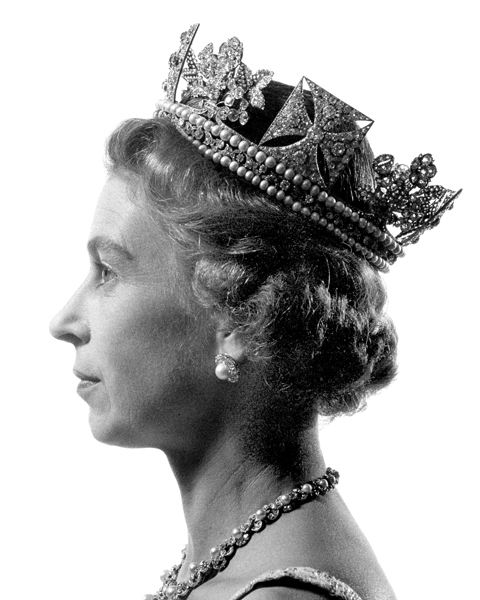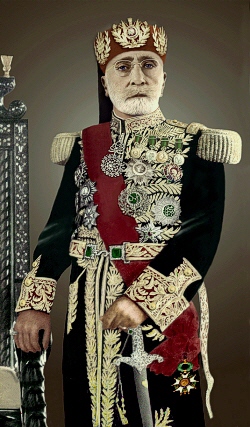Crowns of gold have a potent and conditioning magic. In Shakespeare, reigning Monarchs, Usurpers and Heirs Apparent devote powerful speeches to the Crown’s mystery, hand the thing back and forth, grab it from sleeping brothers, and brood beautifully about its sacred responsibilities. Every child knows that if in the thick of battle you find the crown hanging carelessly upon a thornbush, the thing to do is fit it firmly and instantly over your own helmet.

''Photographer John Hedgecoe, author of more than 30 books on photography and creator of the most reproduced image in the world, the portrait of Queen Elizabeth II that appears on British stamps, has died. He was 73. With a career spanning fifty years, John Hedgecoe was an award-winning photographer who wrote dozens of books on the art of photography that have sold more than nine million copies (His most recent was The Art of Digital Photography in 2006), and was instrumental in establishing the department of Photography at the U.K.’s Royal College of Art in 1965. However, Hedgecoe was most recognized as the photographer who snapped the portrait of Queen Elizabeth II that appears on postage stamps throughout the U.K. and the Commonwealth. The image is widely credited with being the most reproduced image in the world, having sold more than two billion copies to date.''
The most complete study of crowns was completed by Lord Twining. ”A History of the Crown Jewels of Europe” , which documents the history of some six hundred crowns; detailed accounts of regalia and crown jewels in twenty-six European countries over seventeen centuries, an alphabetical order beginning with Austria and ending with Yugoslavia.
Through the book run several major themes, haunting and ominous, though never directly stated. One is power, as the stylized playing card figures of kings and queens succeed and die, are deposed, intermarry, enlarge their territories , put their second-best crowns into pawn, and dazzle the eyes of awe-struck enemies by a sensational display of diamonds. Another is money: the treasures and gems that were used to strike bargains and seal treaties, that were looted and stolen and moved hurriedly in insignificant little boxes during revolutions, that were acquired by penny-wise royal mistresses with a gift for sticking it out, and grabbed back by royal wives, that were thrown out of windows and grubbed for in the gravel, that were once set around minatures of loved faces and made into pretty little earrings and bow brooches, and later sold at auction to dealers and collectors.

''Shah of Iran, Mohamed Reza, posing w. son Prince Reza & wife Farah wearing crown jewels & embroidered robes during coronation''
A third is the irony of changing fortune, especially when kings, who were dangerously mortal, and stones, which are tough and coveted, are the links in the main chain of narrative. A stone can go from an oriental prince’s turban to a crown to a ring to a cloak clasp to a brooch, to a sword hilt; it can be cleft and cut and reset according to the fashion and the growing skill of jewelers and, when the royal cards are packed away in the box, finish up in a state museum.
A history of the crown jewels of Europe is necessarily a history of European monarchies as well, and Lord Twining’s interest was not specifically in jewelry and precious stones but the historical and symbolic attributes of these objects. Still, it is hard not to feel somewhat puritan about these preeminent persons’ need to amass such a stunning quantity of diadems, jeweled girdles, blazing buttons, diamond-dripping earrings , and great waterfall-necklaces so that barely a square inch of themselves remained to be covered by mere silk and velvet.

Sometimes called the Crown of Charlemagne or the Nuremberg Crown, it is an octagon of gold plates, variously enamled and encrusted with precious stones, was for centuries the supreme emblem of the sovereign who bore the title of Holy Roman Emperor. It seems to have been made at a monastery on Lake Constance for the Emperor Otto I in about 961, and possession of it later became a highly important asset for claimants to the throne.
The beautiful stark burial crowns of early Germany and Hungary, old grey wolves of crowns, looking as though they were made for heroic warrior kings, come as an extraordinary relief; and one’s heart warms toward ugly, witty Louis XI of France , who may have made his coronation entry in style with jewels worth a million ”ecus” on his horse’s harness alone, but who for everyday wear preferred an old felt hat decorated with a small leaden saint, and chose to go to his grave very plainly indeed.

''The Catherine the Great’s Ruby is a 398.72-carat, semi-polished, somewhat pear-shaped, blood-red, fiery gemstone, mounted on the top of the Great Imperial Crown. Like all other large rubies of the past found in the jewelry collections of several monarchies around the world, the Catherine the Great’s Ruby is also not a ruby but a large spinel. In the past, when gemology and geology had not developed as a science, spinels were not identified as a separate mineral. The large red stones which displayed a fire of their own were thought to be large rubies, and were considered to be priceless and much sought after by monarchies around the world. The large red gemstones were set in the crowns, tiaras, necklaces and other items of jewelry of the monarchy. The greatest collection of these large red spinels are found in the Crown Jewels of Iran. The British Crown Jewels also contain some very large and famous spinels, l
the Timur Ruby and the Black Prince’s Ruby, previously thought to be rubies.''It is perhaps something similar that makes the four early Russian crowns from the Kremlin Museum look so extraordinarily elegant and appealing. They are like four small jeweled cathedral domes sitting snugly in four wide bands of fur. To all intents and purposes they are in fact, fur hats. They are practical, sensible even, in spite of the grandeur; cozy crowns for cold-weather kings.
Of all the royal headgear in Lord Twining’s ”A History of the Crown Jewels of Europe” , no piece is more renowned than the Hungarian Crown of Saint Stephen, and none has a like history of falling onto the oddest hands and disappearing. Fought over during rten centuries as the symbol of Hungary’s turbulent kingship and nationhood, it has on occasion been hidden in a cushion by a lady in waiting, concealed in the disguise of a baby’s bowl by a queen, buried in a swamp by revolutionary patriots, seized by Red chieftains; and, strangest of all, it rested somewhere in the recesses not of the Hungarian, but of the United States government until returned by Jimmy Carter in a diplomatic gesture in 1978.

Hungarian Crown of Saint Stephen. ''On Christmas of the year 1000, the crown was sent as a gift from Pope Sylvester II to St. Stephen the First King of Hungary commemorating the acceptance of Catholicism in the “Lands of the Crown of Saint Stephen”. The Crown was the physical symbol of the Hungarian Kingdom, present at the coronation of every King of Hungary up to (deposed) Blessed Charles I of Austria. After suffering 30 years of disuse, loss, and disappearance, The Crown of St. Stephen had been recovered by US Troops at the end of World War II, hidden inside of an oil drum, revealed to the Allies by a commandant of the Hungarian Royal Crown guard. It had been stored at Ft. Knox for 32 years preceding the 1978 return, always in process to be returned to Hungary at “some suitable time”.
A low slung cloth cap braced with gold ribs and ornamented with rough cut stones and Byzantine enamel inlays, the crown is not a major jeweler’s item as crowns go; yet a particular aura and mystery surrounds it. Pope Sylvester II appears to have sent at least part of it for the crowning and anointment of Hungary’s first king, Stephen, in the year 1000; where the rest came from is still being debated. No one is sure whether its tilted cross was the result of design or accident. What is known is that for centuries, in order to get yourself made king of Hungary, you first had to gain possession of it by one means or another, which lent to the holder of the ”Holy Crown” far greater powers than those of dynastic birth. The Hapsburg’s commandeered it; Kossuth’s patriots and Bela Kun’s communists in turn seized it from them, and thus, America’s possession of it would have been enough to make Jimmy Carter Hungary’s rightful king.






 COMMENTS
COMMENTS